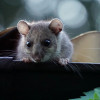Very high flyers
Interview with
Bar-headed geese are among the highest flying birds in the world, who flap their way over the Himalayas! Katie Haylor spoke to Bangor University zoologist Charles Bishop to find out how on earth geese survive, and thrive, these extremely high migrations. About a decade ago, he and colleagues went to the Mongolian breeding grounds of these hardy birds, in order to better understand how they’re capable of making these journeys...
Charles - Well, we're very lucky that ducks and geese go through what’s called a post-breeding moult, which means that they drop all their flight feathers for a couple of weeks while they're raising their youngsters, so we can use canoes to corral them into nets and catch them in reasonable numbers.
Katie - Now, I'm actually quite scared of geese. How easy is it to put a tag on a goose that probably doesn't want to be tagged?
Charles - Actually, bar-headed geese, not only do they look wonderful; kind of white and grey birds with the two black bars across their cheeks that makes them famous and a yellow bill, they actually have a very docile nature. So we had some tags that gave us global position, we could track them every hour or so and over the journeys they were taking the migration could last over a hundred hours of actual flying in total, over many weeks.
We were also interested in how tough are these journeys, and in order to understand the physiology and mechanics of the flight itself, we had accelerometers that gave us wing beat frequency. It doesn't change a lot in a goose but when it does change it indicates a big change in power output so small changes in wing beat frequency would tell us that the birds were having to work much harder. And we could also estimate how deeply they flapped so they would also increase wing beat frequency, at the same time they would actually flap in a deeper, what we would call an increase in their amplitude of the wing so they're creating much higher forces, but this is hard work of course.
And then the heart rate we can use also as a proxy for energy consumption or oxygen consumption. We'd actually flown some geese in a windtunnel many years prior to this, which was very fortunate, where we’d correlated oxygen consumption against heart rate.
Katie - Crucially, you have to get your tags back again so did that involve just going back to the same breeding site and getting back in your kayak?
Charles - Yes. Unfortunately, we couldn't download the tags. We did have to recapture birds in order to obtain the tags. In fact, the GPS ones were satellite-based, but in order to get the accelerometers and the heart rate we did have to recapture the same bird so, of course, we lost a lot of tags because we didn't always see our birds or we couldn't always capture our birds.
Katie - Take us through your findings then, what did you learn?
Charles - We found the birds were very very sensible, so they only seem to fly as high as they needed to, and we call it the rollercoaster strategy because they would effectively follow the underlying terrain. So when there was a high ridge and a barrier, they were capable of going over it but we only recorded a maximum height of 7300 metres directly with GPS. And they wouldn't stay high at those altitudes, not more than multiples of minutes and then they would descend again as the terrain changed. This meant that they actually stayed as low as they could most of the time within a few hundred metres.
Katie - Why wouldn't you just do your ascending and then just stay as high as you need to and fly over the mountains that way? Why adopt this rollercoaster strategy; what's the advantage?
Charles - We concluded from this that the costs of staying high were sufficiently difficult. So the heart rates that we were getting, a goose's maximum heart rate is around 500 beats per minute at sea level, at altitude we are not too sure but we did record heart rates over 400 beats a minute and at maximum 460, but only very rarely; and at altitude that may just be very very hard. The air's getting thinner as they go higher, oxygen's hard to obtain and the forces that they need are getting harder to generate. So thrust takes you forward, keeps you moving, gives you flight speed, and then of course lift keeps you in the air and supports your weight. So they were going down whenever they could to be in denser air where oxygen was more available and generating the forces was easier.
With humans, of course, we have to go to the mountains weeks beforehand before attempting something as high as Everest. Colleagues of mine have put bar-headed geese at rest into an atmosphere of only 5% oxygen. The equivalent of being at the top of Everest is about 7% oxygen, sea level's 21% oxygen, and they were okay, which no human could do.
They also tended to fly at night, not in the day. We weren't expecting that with the geese in that we kind of thought that they might use winds that might assist them, so if they could get a tailwind you'd be covering the ground much quicker and cuts the cost of the total journey.
Katie - Why would it be beneficial for the geese to fly in darkness? I would have thought it's just more difficult to see where you're going.
Charles - Possibly, you can avoid predation by flying at night. Another possibility is that it's much colder of course and it could drop 20/30° C. The effect of that would be to increase air density so it would effectively be like flying maybe 500/800 metres lower, so by flying at night when the air is cooler, the air is denser, so again, generating forces is easier, oxygen availability also increases.
Katie - So how are birds able to cope with getting the oxygen into their bodies, which seems to be more difficult the higher up you go, how do they compare to humans?
Charles - Birds seem to be better adapted to high altitude. The lung systems and the ability to circulate oxygen through the body does appear to be innately superior. Their lung systems are fundamentally very different in design. They actually have what we call unidirectional flow so it passes through the lungs from one side to the other. It doesn't expand and contract like a human lung but it does have associated air sacs that permeate throughout the body of the bird and they expand and contract. And they act like bellows so when the bird breathes in it fills up some air sacs, then when it breathes out those air sacs empty and actually pass the air through the lung tissue and you get gas exchange, oxygen uptake, CO2 output. Then, when you think they're breathing in again, they're actually pushing that air out to the forward air sacs and then finally it all goes out on the second out breath. Probably makes the bird lungs more efficient perhaps at altitude in particular, the surface area for that gas exchange is probably twice as great as most mammals.










Comments
Add a comment